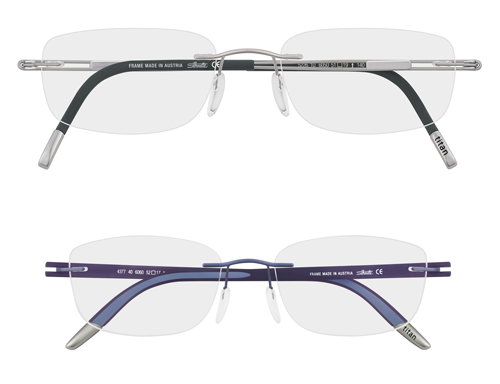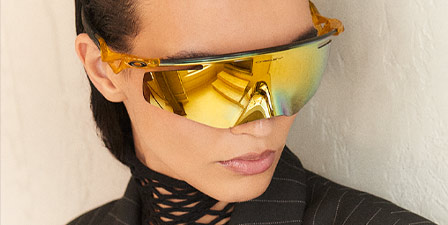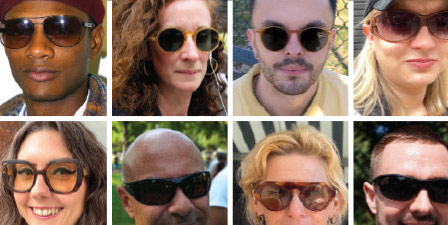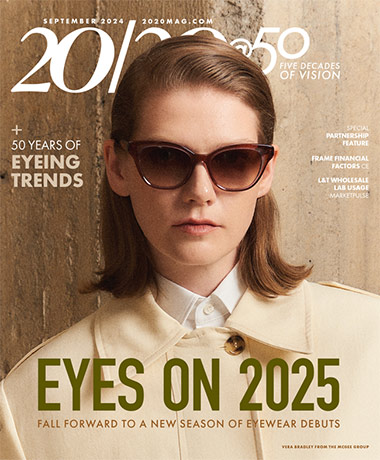Every person who wears eyewear is unique, and the eyewear
they love to wear should be just as unique - Silhouette, 1964
These days, customization is king.
From specialty window tints to iPhone skins, desktop backgrounds to the burgeoning impact of tattoo culture, we live in an age where everyone wants to make their own, personal mark on something. Yet for all of the emerging methods with which individuals can customize their clothes, technology, and bodies, one simple yet effective means of personal modification has existed for well over a hundred years: Rimless glasses.
As I mentioned in a previous article, rimless glasses are amongst the oldest of the styles that have remained in vogue, first rising to popularity as part of the pince nez craze. Yet, for those early adoptees, rimless glasses weren’t a means of personalization; they were a way to make their lenses less noticeable. A cursory glance at surviving rimless glasses from the early 1900s makes this clear: Although, theoretically, a skilled optician could make any shape in any size for any person, virtually all of the lenses we have from the era adhere to the round/oval schema found among rimmed glasses of the day, with octagons entering the fray when that shape gained some popularity. Yet any optician who has ever worked with an image conscious patient knows there are countless varieties of face shapes and sizes, and that those three shapes aren’t a catchall answer to every facial iteration. Rectangles? Squares? Trapezoids? Teardrops? Nary one to be found amongst the rimless lenses of the early 20th century. Glasses had yet to take on any kind of adventurous quality; for all of the possibilities that rimless frames offered, virtually no one was ready to take that plunge.
Not so today.
I first learned of the joys and possibilities of rimless glasses over five years ago, when I finally decided to trade in the semi-rectangular wire rims I’d worn for the previous three years. I wanted something timeless, something that would be fashionable today but also chicly retro. Rimless seemed to be the direction to go. Having a very squat, square face, though, my lens options seemed to be limited, especially if I wanted to maintain an authentically classic look. Taking a pair to my then-optician, I asked if it would be at all feasible to modify the demo lenses in my frames to suit the parameters of my face? I’d expected a “no” of some sort, an explanation on how that would somehow affect the optics or how the facilities were limited in their capabilities, and prepared to settle for a shape that would torpedo the look I was going for.
To my pleasant surprise, I got a “sure, no problem.”
It’s to my great shame that I spent the next several weeks harassing the heck out of the poor, beleaguered lab tech that had taken on the mantle of custom making a pair of lenses for me. I don’t think a three day period went by that I didn’t either drop in on the lab on my way home from work or call them up in between breaks from class; having worked on the other side of the bench, I now know too well the frustration I put that poor guy through, and, if he’s reading this: I am so sorry.
It’s to his credit, though, that in the face of my borderline stalking, he still produced a unique work of optical art that I very happily and proudly wore for the next several years. To this day, though, I’m still a fan of rimless glasses, and still value the magnificent possibilities, which they offer wearers (rimless glasses are, in fact, my second favorite type of glasses. Yes, I have a list). Although a custom look is one of the principal end goals in frame selection (after accounting for all factors conducive to the wearer’s prescription), total customization is still limited by the physical confines of rimmed glasses. There’s no way to stretch or shrink or reshape a rimmed frame—what’s offered is what’s offered, and it’s a matter of finding the right combination of size and angles for the wearer’s face. As my own experience demonstrated, a skilled optician working with the proper equipment can tweak the lenses to the wearer’s facial features and specifications while also taking into account Rx accuracy and other wear variables.

This, of course, is to say nothing of the variety of shapes offered by manufacturers “out of the box.” In a phenomenon I’ll call “Off the Rack Customization,” the shapes, sizes, and frame choices offered by manufacturers now for rimless wear are of such a great variety that many wearers seeking a unique look needn’t even worry about the potentially labor-intensive process of designing a lens with an optician. Take Silhouette—though the company is celebrating its’ 50th anniversary this year, the 1990s was indisputably the decade which put the company on the map as the purveyor of rimless eyewear, to the point that their name has become synonymous with their top-selling product. It isn’t a reputation that’s unearned: A given frame can have up to 8 different lens shapes available for mounting in 8 different chassis colors, a breadth of customization which puts the round/oval/gold/silver combos of the 1920s to shame.

And while some rimless manufacturers are content to offer five variations on a rectangle and call that a “selection,” Silhouette’s offerings truly run the gamut from classic to edgy: Those rectangles are still there, of course, as are variations on perfect circles for those who want to achieve a Steve Jobs look; then, there are those that really stand outside of the box, like the aviator teardrop shape that I’m not brave enough to wear but which I’m sure looks awesome on whoever out there actually had the guts to have it put into his frames. What’s more, Silhouette offers an online app that opticians can use in office to help patients determine which frame color, style, and lens shape they would like best. Simply by using a smart phone to take a photo of the patient and then uploading it to Silhouette’s website, opticians and patients can browse the plethora of styles and combinations offered by the company. For those a bit more squeamish to make big decisions or those reticent to be too opinionated, there’s also an interactive survey that allows patients to fill in information about themselves (such as gender, face shape, and lifestyle) that will generate suggestions on where to start in the quest for perfect customization.

Click above to take the Silhouette online eyewear profile survey
Men’s clothing guru Alan Flusser is popularly attributed with the quote that “While fashion is fleeting, style is eternal.” Rimless glasses may not always be in fashion, but they have remained, since their inception, a timeless and forever stylish alternative to trendier, more obtrusive models of the day. With today’s rampant desire to leave a mark on everything, Silhouette is the perfect starting point for those seeking the ultimate in customization and timely, timeless appeal.

Preston Fassel was born in Houston, Texas and grew up between St. Charles, Missouri and Broken Arrow, Okla.
In 2009, Preston graduated Summa Cum Laude with a degree in Liberal Arts. In 2011, he graduated Cum Laude from Sam Houston State University with a Bachelor's of Science.
Preston currently works as an Optician in the Houston area. His interest in the history of eyewear goes back to his time in high school, when he developed an interest in all things vintage.
In addition to his writing for The 20/20 Opticians Handbook and 20/20 Magazine, Preston is a featured writer for Rue Morgue Magazine, where he reviews of horror and science-fiction DVDs. His fiction writing has been featured three times in Swirl magazine, the literary arts journal of Lone Star College and Montgomery County. He is the author of the definitive work on the life of British horror actress Vanessa Howard, Remembering Vanessa, which appeared in the Spring 2014 edition of Screem Magazine.
Preston lives in Conroe, Texas with his wife, Kayleigh, and his ego, Ted.
This content sponsored by Silhouette Optical, Ltd.












